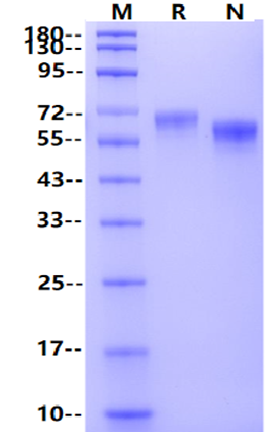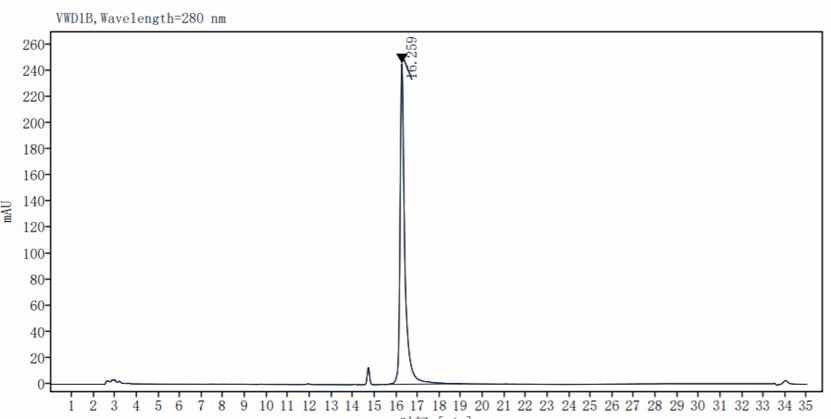Gln30-Glu403, with C-terminal 8*His
QETELSVSAELVPTSSWNISSELNKDSYLTLDEPMNNITTSLGQTAELHCKVSGNPPPTIRWFKNDAPVVQEPRRLSFRSTIYGSRLRIRNLDTTDTGYFQCVATNGKEVVSSTGVLFVKFGPPPTASPGYSDEYEEDGFCQPYRGIACARFIGNRTVYMESLHMQGEIENQITAAFTMIGTSSHLSDKCSQFAIPSLCHYAFPYCDETSSVPKPRDLCRDECEILENVLCQTEYIFARSNPMILMRLKLPNCEDLPQPESPEAANCIRIGIPMADPINKNHKCYNSTGVDYRGTVSVTKSGRQCQPWNSQYPHTHTFTALRFPELNGGHSYCRNPGNQKEAPWCFTLDENFKSDLCDIPACDSKDSKEKNKMEGGGSHHHHHHHH
56-70kDa (Reducing)
>95% by SDS-PAGE&RP-HPLC
Receptor tyrosine kinase-like orphan receptors (RORs) are monotopic membrane proteins belonging to the receptor tyrosine kinase (RTK) family. RTKs play a role in the control of most basic cellular processes, including cell proliferation, differentiation, migration and metabolism. ROR1 contains 1 FZ (frizzled) domain, 1 Ig-like C2-type (immunoglobulin-like) domain, 1 kringle domain, 1 protein kinase domain. ROR1 is highly expressed in a wide variety of hematological and solid cancers, but is low or absent in adult tissues. ROR1 could interact with casein kinase 1 epsilon (CK1ε) to activate phosphoinositide 3-kinase-mediated AKT phosphorylation and cAMP-response-element-binding protein (CREB). Studies have demonstrated that it plays an important role in oncogenesis by activating cell survival signaling events, particularly the non-canonical WNT signaling pathway. Antibody-based immunotherapies targeting ROR1 have been developed and evaluated in preclinical and clinical studies with promising outcomes.



Immobilized ROR1 His Tag, Human (Cat. No. UA010137) at 2.0μg/mL (100μL/well) can bind Anti-Human ROR1 Monoclonal Antibody (Zilovertamab) with EC50 of 2.02-2.71ng/mL.